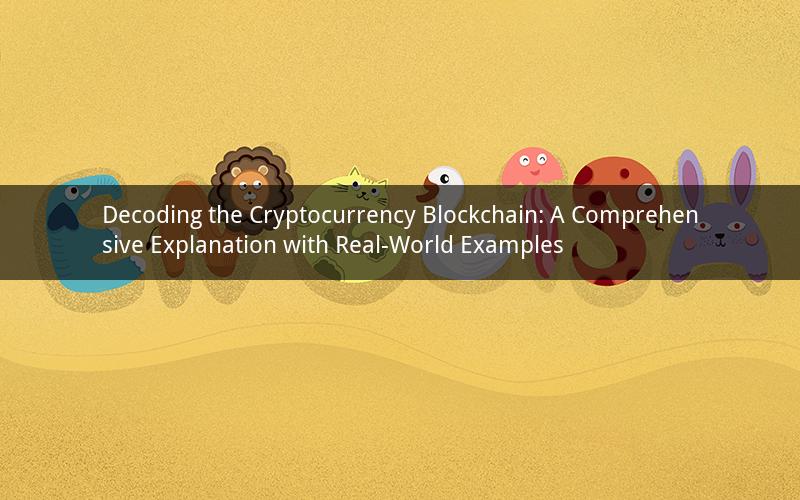
Introduction:
Blockchain technology has revolutionized the financial industry by introducing a new way to conduct transactions securely and transparently. At its core, a blockchain is a digital ledger that records all transactions in a chain of blocks. This article delves into the intricacies of blockchain in cryptocurrency, providing a detailed explanation with real-world examples.
1. What is a Blockchain?
A blockchain is a decentralized digital ledger that records transactions across multiple computers, known as nodes. Each transaction is grouped into a block, and these blocks are linked together in a chain. This chain of blocks ensures the integrity and immutability of the recorded data.
2. How does Blockchain Work?
Blockchain operates on a peer-to-peer network, where each node has a copy of the entire ledger. When a transaction occurs, it is broadcasted to all nodes in the network. Nodes then validate the transaction using consensus algorithms, such as Proof of Work (PoW) or Proof of Stake (PoS).
Once a consensus is reached, the transaction is added to a new block. This block is then appended to the existing chain, creating a continuous and tamper-proof record of all transactions. The decentralized nature of blockchain ensures that no single entity has control over the entire network.
3. Cryptocurrency and Blockchain: An Unbreakable Bond
Cryptocurrency, such as Bitcoin, is the most well-known example of a digital asset built on blockchain technology. The two are inherently connected, as blockchain serves as the underlying technology that facilitates the secure and transparent transfer of cryptocurrency.
4. Real-World Example: Bitcoin
Bitcoin, launched in 2009, is the first decentralized cryptocurrency. It operates on the blockchain network and utilizes the PoW consensus algorithm. Here's how Bitcoin transactions are processed:
- When a user wants to send Bitcoin to another user, the transaction is broadcasted to the network.
- Nodes in the network validate the transaction, ensuring that the sender has enough Bitcoin and the transaction is legitimate.
- Once the transaction is validated, it is added to a new block.
- Miners, who are responsible for securing the network, compete to solve complex mathematical puzzles to add the block to the blockchain.
- The first miner to solve the puzzle gets the right to add the block and receives a reward in Bitcoin.
- The newly created block is added to the existing chain, and the transaction is recorded.
5. Advantages of Blockchain in Cryptocurrency
- Security: Blockchain's decentralized nature makes it highly secure, as no single entity has control over the entire network.
- Transparency: All transactions are recorded on the blockchain, making it transparent and easily verifiable.
- Immutability: Once a transaction is added to the blockchain, it cannot be altered or deleted, ensuring the integrity of the ledger.
- Decentralization: Blockchain eliminates the need for intermediaries, reducing costs and increasing efficiency.
- Innovation: Blockchain technology has paved the way for various applications beyond cryptocurrency, such as smart contracts and decentralized finance (DeFi).
6. Future of Blockchain in Cryptocurrency
The blockchain technology is expected to continue evolving, with potential advancements in scalability, energy efficiency, and interoperability. Here are a few trends to watch out for:
- Scalability: Blockchain networks are working on solutions to handle a higher number of transactions per second, addressing the scalability issue.
- Energy Efficiency: As mining consumes a significant amount of energy, research is being conducted to make blockchain more energy-efficient.
- Interoperability: Efforts are being made to enable different blockchain networks to communicate and transact with each other, creating a more interconnected ecosystem.
Frequently Asked Questions:
1. What is the difference between a blockchain and a database?
A blockchain is a type of database, but it has specific features that differentiate it from traditional databases. Blockchain is decentralized, tamper-proof, and operates on a peer-to-peer network, while databases are centralized and can be altered by a single entity.
2. How does blockchain ensure security?
Blockchain ensures security through its decentralized nature, consensus algorithms, and cryptographic techniques. Each transaction is validated by multiple nodes, and once added to the blockchain, it cannot be altered or deleted.
3. What is a cryptocurrency wallet?
A cryptocurrency wallet is a digital tool used to store, send, and receive cryptocurrency. It can be a software application or a physical device and is essential for managing cryptocurrency transactions.
4. Can blockchain be used for applications beyond cryptocurrency?
Yes, blockchain technology has various applications beyond cryptocurrency, such as smart contracts, supply chain management, healthcare, and more. Its decentralized and transparent nature makes it suitable for industries requiring secure and transparent record-keeping.
5. How does blockchain contribute to the fight against fraud?
Blockchain contributes to the fight against fraud by ensuring the integrity and immutability of the recorded data. Since transactions are transparent and tamper-proof, it becomes easier to detect fraudulent activities and investigate them.